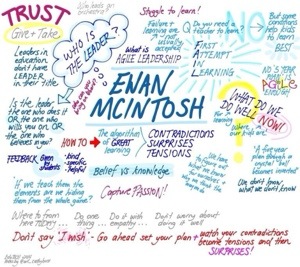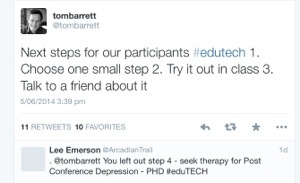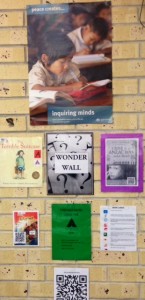
Find more education infographics on e-Learning Infographics
Category Archives: Digital Technologies
ICLT INNOVATION & E-LEARNING DAY
CREATE AN APP
In reflection
Blippit – the original pop-up app maker from Get Logged In on Vimeo.
Please note: the apps created with Blippit are no longer active.
As of March 2014 Blippit has changed to Blippit IO App Maker.
To retain the work of the students this presentation was created.
Design thinking @Edutech2014
I was fortunate enough to attend a Masterclass at Edutech this year.
“Design thinking in the Australian Curricululm” with Ewan McIntosh @notosh (and Hamish Curry and Tom Barrett).
The sessions were fast and furious (I went through four pencils in the Immersion and Synthesis stage of the process).
Simple, yet effective ideas like the six word stories are wonderful ‘I can implement tomorrow’ ideas.
I think that a tool like Haiku Deck would be excellent to visualise these as well.
I am currently in the synthesising phase of how to actually implement this process at SALC. The concepts have great potential not only for use with the Australian Curriculum but perfect for the inquiry method in the PYP. I LOVED the idea of using TED talks to generate a “generative topic” and the challenging nature of them.
@art_cathyhunt visual notes – nice!
What’s in a word? Meaning and intention? Does it make a difference? Emotive words and hidden intent?
The focus on a key word in statements was frustrating (as often words used could be interchangeable) yet I understood the purpose and importance of the selection of language.
See some tweets – #Edutech
Lots of food for thought. Stay tuned for where we go next.
Technology, design & authentic problem solving
Maker Spaces, Design Thinking & STE(A)M
Ideas in the making…. Just some thoughts
- Significant Challenges Impeding K-12 Ed Tech Adoption
- Difficult Challenges: Those that we understand but for which solutions are elusive
- Complex Thinking and Communication
- Integrating Personalized Learning
- Solvable Challenges: Those that we understand and know how to solve
- Creating Authentic Learning Opportunities
GET UNBORED
PS: This week I visited PIMPAMA STATE SECONDARY COLLEGE and saw their design thinking in action. Looking forward to seeing the next stage of their journey.
Design Minds EXPLAIN from State Library of Queensland on Vimeo.
Digital Technology resources using Storify
Diigo Digital Technologies weblinks
Join my Digital Technologies Diigo group.
Resources shared to this diigo group are resources to support the teaching and learning in the Technologies curriculum.
New members are welcome.
Making Connections with apps
Making connections….
with what we do in the JS Library and what is possible in the classroom.
I believe that FOTOBABBLE is an excellent tool for Lower Primary classrooms as it is simple to use as it uses image and audio to create a shareable moment.
It is also web browser friendly, iPad friendly (using an iPhone app) and free!
This is an example of a fotobabble about new resources in the library and the connections to the PYP.
This tutorial about using FOTOBABBLE in the classroom explain the features, as well as some uses for FOTOBABLE in the classroom.
Show me how!
Year 6 have been learning the process to create a presentation using the Show Me app or the Explain Everything app. These are excellent tools that will be useful to help prepare for the Exhibition later this year.See below for the first two students who have submitted their tutorial or presentation.
See the ICLT4ME Student Reviewed Apps for more examples.
More will be added to our WONDER WALL(s) in the JS Library as the students complete them.
These display spaces in the JS Library are Showcasing student work and reflections, or support resources for the UOIs. They are activated by QR codes and the Aurasma app.
PREZI
THE YEAR SO FAR…









